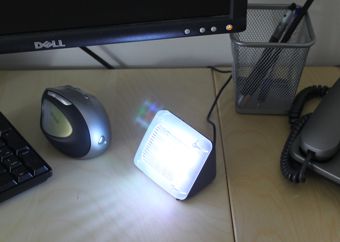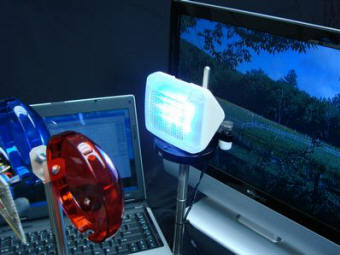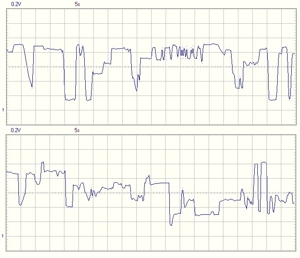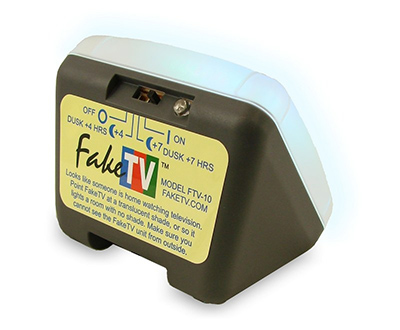The Technology Behind FakeTV
This page is for the very curious and the true techies. To make your home a little safer, you do not need know how FakeTV works, just that it works really well.
Partly about Light…
How does something the size of a coffee cup produce as much light as a television set many times its size? Recent advancements in LED technology have brought about “Super Bright LED’s”, more than ten times as bright as the “plain old LED’s” we are all familiar with. FakeTV packs a dozen of these technological marvels into a package that includes a computer and some well-designed optics. The FakeTV diffuser lens is a bit of science (optics is what we do here!) that borders on art. Forgive our boasting, but the FakeTV unit is very pleasing to the eye.


Gathering television light output data from dozens of different program sources and televisions was not just an excuse for engineers to watch TV during the day. Okay, maybe a little.
Partly about Random
FakeTV is not just a flickering light or flasher! And neither is it just a “random light source.” We get kind of annoyed when people call it that. Yes, there are random number generators in the computer in FakeTV, and FakeTV never, ever, repeats. Real TV is not random- any more than music is random sounds. The light from TV is highly characteristic. Discovering what makes the light from a TV look like, well, the light from a TV, was the key to making FakeTV so realistic.
Play Spot the Fake
One of these graphs shows the measured light output of a real LCD television, and the other shows the measured light output of a FakeTV. Which one is the real TV and which is the impostor? We are not saying*! There is no way to tell from these graphs, and that’s the point.


But mostly about a really good counterfeit!
To develop FakeTV, we took data using real televisions of different types and makes. We characterized TV programs, analyzing the light output for intensity and color variation. We generated a lot of computer files of television data. Then, we came up with mathematical formulas that behaved just the same way. We programmed these into FakeTV’s computer, and ran the same tests.
Okay, we got a bit compulsive about this. Surely, no burglar has ever studied the light intensity output of a television, or measured the degree of color variation! But we human beings are remarkably good at discerning patterns and even subtle differences. We did not want to take the chance that a prowler might see the light from our television simulator and think “something is not right, there”, even if he could not identify it. We kept at it until we could see, and measure, no differences. This is because an obvious simulation runs the risk of announcing the prowlers that the home is, in fact, unoccupied. We did not want to take that chance.
We didn’t stop with just a great imitation of TV light, either. The FakeTV unit is extremely usable. The light sensor works very well, so in most applications all you need to do is plug it in, set the timer switch appropriately, and let it mislead burglars for you.

We tested these in the field, as well. We verified that our test subjects simply could not tell the difference between FakeTV and the real thing. We were the first to do such analysis, and our invention has yielded several US and international issued and pending patents.
Accurately Simulates Romantic Comedies. Faithfully Emulates Sportscasts.
Believe it or not, a news program looks very different from a music video when you just view the light it cast on your drapes. FakeTV, in its computer brain, decides what sort of program it is going to be simulating for a period of time. It may, say, think that it is supposed to be serving up a romantic comedy, and then produce relatively static content, with few scene changes and relatively little color. Then it might decide to go to commercial break (no, you can’t fast-forward your FakeTV) and the lights will dazzle with rapid scene changes and vibrant colors. FakeTV might decide it’s an outdoor meadow scene, and serve up more green for a few minutes. Or, the next 10 minutes might have a lot of blue. (The ocean scenes are like that you, know.)
Was all this sophistication overkill? Maybe. But it was actually kind of fun to design.
*Okay, you dragged it out of us. The bottom graph is data we gathered from the Disney movie “The Incredibles”, and the top from FakeTV. We wanted FakeTV to be on the bright, colorful, and dynamic side of what is realistic, but not more dynamic or colorful than real television programming. For these graphs we picked a couple periods where the light was very dynamic. Other times are relatively static, both for “The Incredible’s” and for FakeTV. Overall, the program whose light output most closely resembles that of FakeTV is “The Incredibles.”